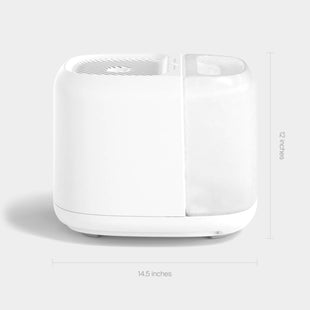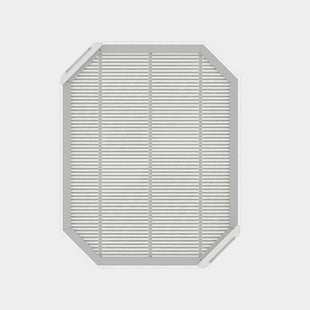If you spend just 5 minutes on Instagram, you will undoubtedly encounter a handful of high brow content creators and celebrities boasting the incredible benefits of regular humidifier use for your skin, your hair, your newborn, and your general peace of mind.
Humidifiers are everywhere, and they are here to stay.
So, what’s the deal with humidifiers?
A humidifier is a device that disperses moisture into the surrounding environment to elevate the relative humidity of a particular space. There are three types of humidifiers: ultrasonic humidifiers, evaporative humidifiers, and vaporizers.
In this post, we will focus specifically on ultrasonic humidifiers and answer a few of your most pressing questions on the topic, including:
- What is an ultrasonic humidifier?
- How does an ultrasonic humidifier work?
- What are the pros and cons of an ultrasonic humidifier?
- How do you clean an ultrasonic humidifier?
For more information on vaporizers, you can read our blog Humidifier vs. Vaporizer.
The Ultrasonic Humidifier

An ultrasonic humidifier is, of course, a humidifier. As we mentioned in the introduction, a humidifier elevates the relative humidity of a particular space. So an ultrasonic humidifier elevates relative humidity.
As with evaporative humidifiers and vaporizers, an ultrasonic humidifier has a water reservoir, which it draws from to disperse moisture into the surrounding environment. An ultrasonic humidifier, however, uses a metal diaphragm to create the fine mist, which ultimately escapes the device and enters your space.
So, how exactly does an ultrasonic humidifier work? Let’s dive deeper.
How Does an Ultrasonic Humidifier Work?
Though the term “ultrasonic” sounds complex and oddly similar to language used in Star Trek, the technology is pretty simple.
At the bottom of the water reservoir on an ultrasonic humidifier is a small, metal diaphragm. This metal diaphragm uses high-frequency sound vibrations to propel tiny water droplets through the nozzle and into the surrounding environment. When the microscopic water droplets enter the air, they evaporate and leave the air around the humidifier more hydrated than before.
Since ultrasonic humidifiers do not heat the water in the device tank, they are considered “cool mist” humidifiers alongside evaporative humidifiers. Vaporizers are considered “warm mist” humidifiers since they boil the water from the water tank to create vapor, which is released into the room with a slight warming sensation.
The Pros and Cons of an Ultrasonic Humidifier
Any smart shopper would weigh the pros and cons of a device before making a purchase. To help you determine whether an ultrasonic humidifier is right for you, let’s weigh the pros and cons of this particular style of humidifier.
The Pros
- The ultrasonic humidifier does not use a filter, which requires less operational work on your part.
- Ultrasonic humidifiers and evaporative humidifiers are considered the safer option if you plan to use the humidifier in your child’s room. Warm mist humidifiers are classified as a burn hazard by the American Academy of Pediatrics.
- The metal diaphragm of an ultrasonic humidifier requires very little space, which allows for a smaller design. As a result, ultrasonic humidifiers are available in very compact sizes (there are some ultrasonic humidifiers that you can just drop into a glass of water).
- Ultrasonic humidifiers are very quiet, and make only a slight humming sound.
- Ultrasonic humidifiers are energy efficient, particularly when compared to vaporizers.
The Cons
- Since the ultrasonic humidifier does not have a filter, it requires distilled water to prevent mineral buildup in the device tank. If you plan to use your humidifier regularly, the cost of distilled water for your humidifier could add up.
- The lack of a filter in the ultrasonic humidifier also creates room for bacteria growth and mold growth in the water tank, which could be dispersed into your room without knowledge.
- Ultrasonic humidifiers can then expel this mist from your device, which can land on hard surfaces, curtains, bedding, and other materials adjacent to the device further exacerbating the spread of bacteria and mold, which can be incredibly harmful to you and your family if left unattended.
- If you are looking to use a humidifier as a noise machine for your newborn, the ultrasonic humidifier will not provide an effectively calming sound.
Canopy Humidifier vs. Ultrasonic Humidifiers
Canopy humidifiers are designed with your safety in mind. For every con with the ultrasonic humidifier, Canopy has a solution.
Canopy humidifiers are anti-mold. UV lights kill 99.9% of bacteria that can grow in the device water tank. What about that last 0.1% of bacteria? Canopy’s disposable paper filter swoops in at the last minute to ensure no bacteria or mold enters your environment.
Canopy humidifiers are mistless. No mist, no mess. Canopy humidifiers expel pure, hydrated air rather than messy mist. You can sleep easy knowing that your Canopy humidifier is tidy and contained with no worry about messy mist ruining your fabric or wood surfaces.
Canopy humidifiers are easy to clean. Cleaning your Canopy humidifier could not be any easier. Simply disassemble your Canopy humidifier and place all components in your dishwasher on a normal cycle. That’s it!
How Do You Clean an Ultrasonic Humidifier?

Cleaning your ultrasonic humidifier regularly is absolutely imperative to prevent harmful contaminants from entering your home air and to extend the longevity of your device.
There are 5 steps to effectively cleaning your humidifier device:
- Disassemble your device, removing all removable parts
- Place all small, removable parts (without electrical components) in a vinegar soak
- Scrub the inside of the water tank with a scrub brush
- Wipe the exterior of the device with a vinegar soaked cloth
- Rinse all parts (without electrical components) with fresh water and let them air dry on a cloth towel
How Often Should You Clean Your Ultrasonic Humidifier?
As a general rule of thumb, you should clean your ultrasonic humidifier every other use if you use your device weekly.
If you use your humidifier a few times per month or less frequently, you should clean the device before each use to ensure that the water tank has not grown mold or harbored bacteria.






























